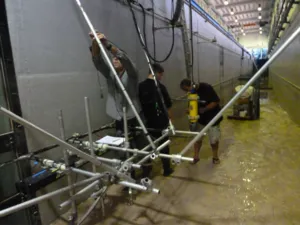
Professor Peter Thorne and Dr Richard Cooke of the National Oceanography Centre in Liverpool travelled to Barcelona recently to take part in an international study on boundary layer sediment dynamics.
The boundary layer in this case refers to the layer of water next to the seabed. Here, flowing water mixes more vigorously than the ocean’s interior, because this is where the ocean rubs against the seafloor. Consequently, water in the boundary layer can re-suspend and transport seafloor sediments.
In coastal and estuarine waters around the globe, the mobility of seabed sediments impacts a range of marine processes, from physical and chemical, to biological and ecological. Understanding and modelling sediment transport is therefore central to coastal zone management.
The study used acoustic instrumentation to propagate sound waves through the water-bed interface to obtain sediment transport profiles, both horizontally across the boundary layer and vertically into the bed sediments. Prof Thorne and Dr Cooke deployed the newly developed Acoustic Suspended Sediment Imager (ASSI), to image suspended sediment and bedforms. The ASSI was designed in Liverpool and trialled earlier this year.
Prof Thorne said, “This study will provide some of the most detailed measurements of boundary layer sediment dynamics, which will be used to assess and develop sediment transport models.”
The study is part of the Water-Interface-Sediment-Experiment, WISE, which aims to study sediment dynamics at the water-bed interface using state-of-the-art measurement systems, and is a joint research activity within the EU HYDRALAB-IV project ‘More Than Water’ (https://www.hydralab.eu).
Collaborators Dr David Hurther, Dr Pierre-Alain Barraud and Dr Jean-Marc Barnoud of the University of Grenoble tested a new acoustic velocity and concentration profiler, and Drs Agustín Sánchez-Arcilla and Iván Cáceres of the Catalonia University of Technology provided the infrastructure and conventional instrumentation for the experiment.
The experiments took place in the large-scale wave channel at Catalonia University of Technology.